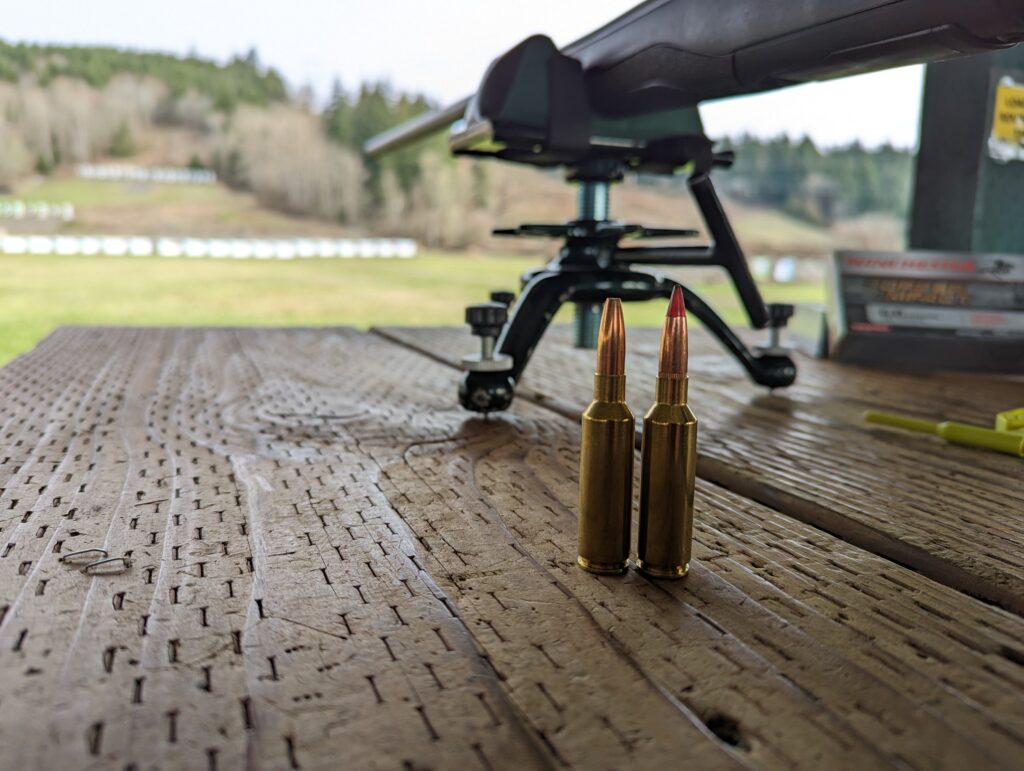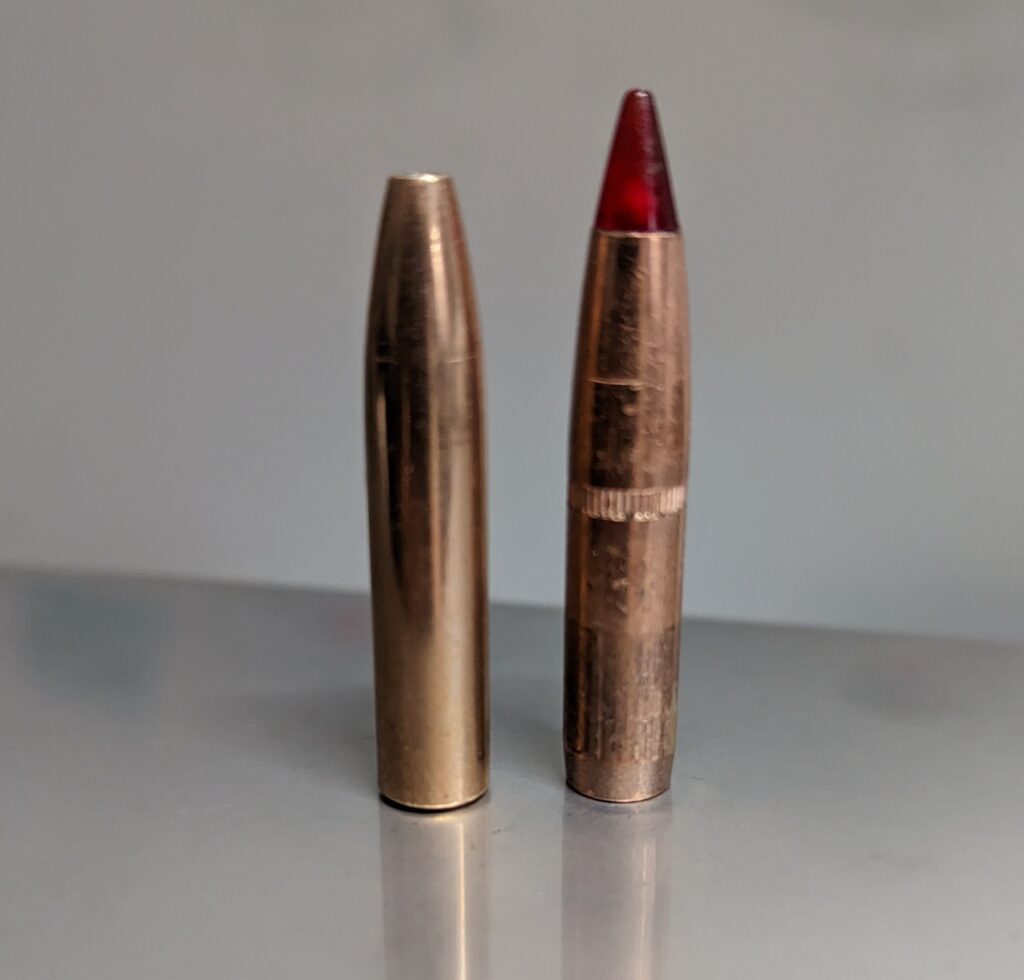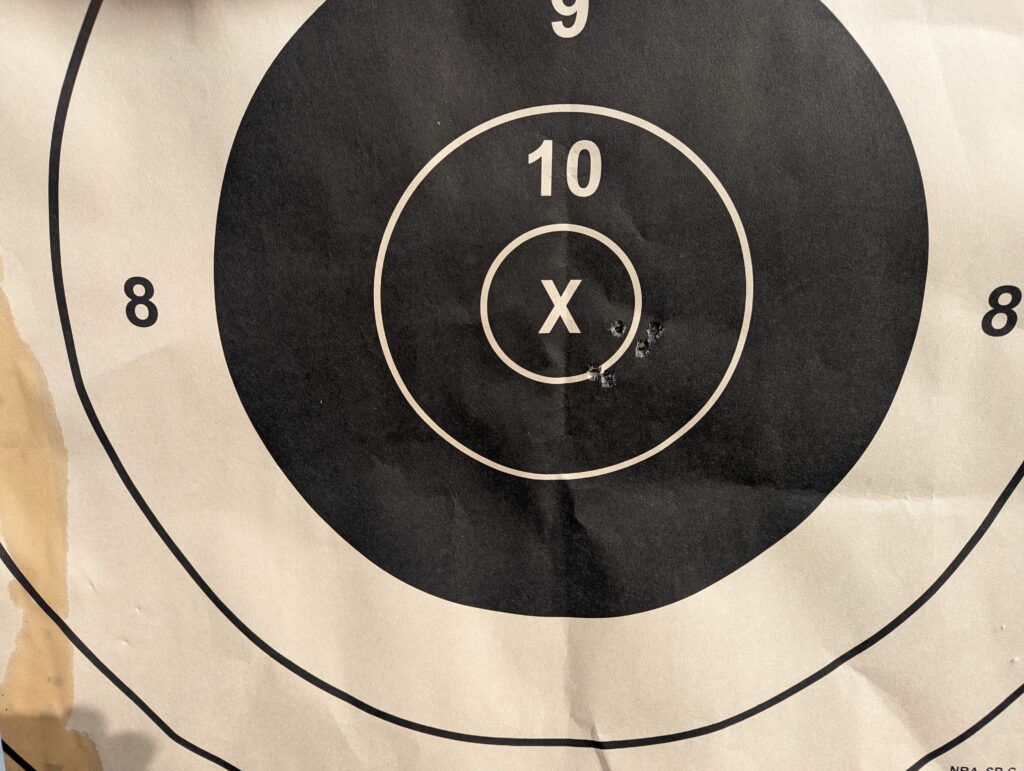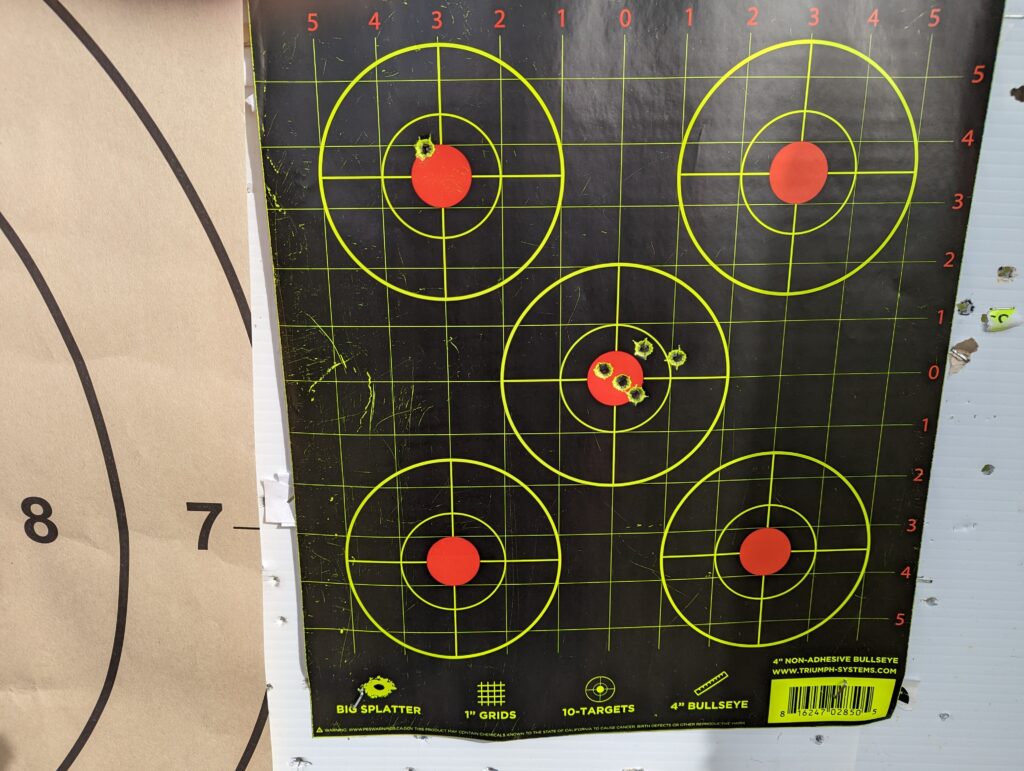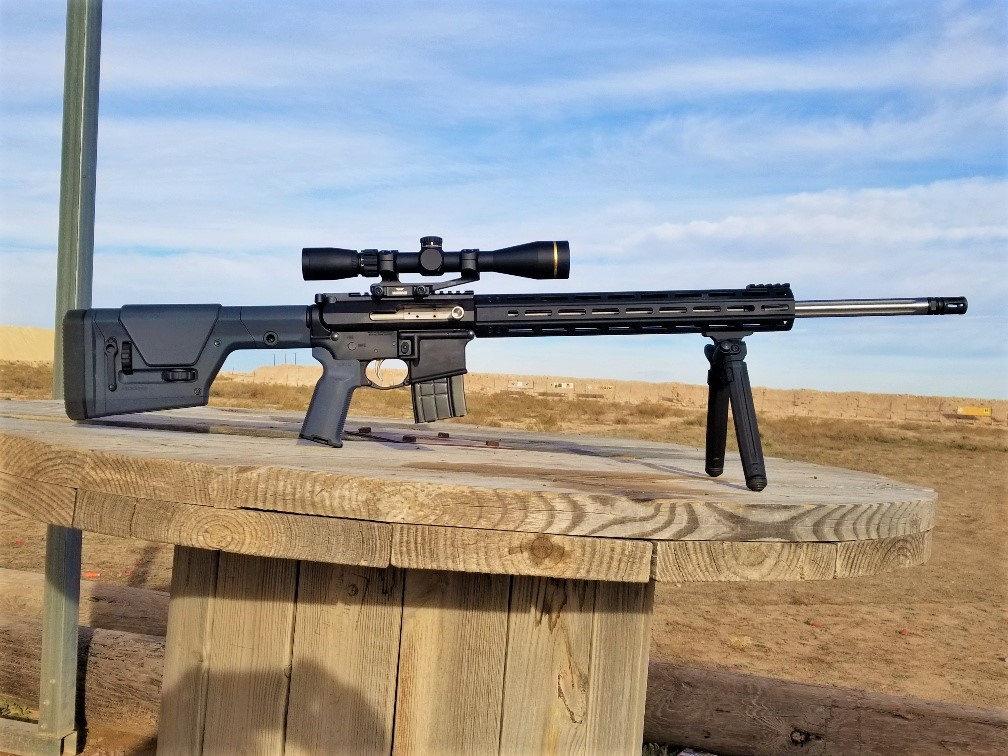Updated June 24, 2017
The 6.8 SPC caliber makes for great medium sized game hunting from hogs to deer to black bears and more. The 6.8 has mild recoil, and a lightweight rifle chambered in this caliber is ideal for hunts in which you put a lot of miles on your feet, up and down in hilly terrain. The mild recoil is preferred for anybody, but especially so for young hunters, women hunters, or anyone who wants a lightweight easy shooting rifle. My 18″ 6.8 is what I choose when I’m hunting deer in central and eastern Washington State. I’m not considering the ultra-mild recoiling .223 because it’s not legal for big game hunting in many states, my home state of Washington included.
The standard youth deer rifle appears to be a bolt action .243 Winchester with a 20″ barrel. I’ve never shot one but I’m told it has mild recoil, which I find surprising given that the .243 Win is based on a .308 parent case. My goal with this post is to compare the 6.8 SPC to the .243 Win. I want to compare external ballistics, recoil, and report / sound level – as every good parent wants to protect their child’s hearing as much as possible. Using QuickLoad as the tool for internal ballistics, and Hornady’s external ballistics calculator for down range performance, we can compare performance against several metrics.
Recoil
For most of us dad’s out there, we want our kids to have fun hunting and shooting. We start them young, and the last thing we want is a flincher because we started them with too much gun. Turns out the 6.8 SPC and .243 Win are great choices for youth hunters and shooters in terms of recoil. To see why we can compare the recoil force due to the impulse imparted by shooting on the rifle and shooter. The entire process of powder ignition to bullet exit at the muzzle takes about 1 millisecond. The force imparted to the rifle can be estimated from the impulse based on the following formula:
![Rendered by QuickLaTeX.com \[ J = F (t_2 - t_1), \]](https://www.bisonops.com/wp-content/ql-cache/quicklatex.com-d81232612cd6d8bcd60bb35c6c6e0c60_l3.png)
which is the impulse due to a constant or average force,  , applied over a timespan starting at
, applied over a timespan starting at  and ending at
and ending at  . An impulse is a change in momentum so we can also compute the impulse
. An impulse is a change in momentum so we can also compute the impulse  as
as
![Rendered by QuickLaTeX.com \[ J = mv_2 - mv_1 \]](https://www.bisonops.com/wp-content/ql-cache/quicklatex.com-6330aa944a335a05d92df305aad5a610_l3.png)
where  is the starting velocity and
is the starting velocity and  is the end velocity, and m is the mass that we assume does not change for this analysis. From the previous two equations we can make the following equation:
is the end velocity, and m is the mass that we assume does not change for this analysis. From the previous two equations we can make the following equation:
![Rendered by QuickLaTeX.com \[ mv_2 - mv_1 = F (t_2 - t_1) \]](https://www.bisonops.com/wp-content/ql-cache/quicklatex.com-5dcf73fa8335b1563046fdb88f629806_l3.png)
And then we solve for the average force that would result from the given impulse
![Rendered by QuickLaTeX.com \[ F = m (v_2 - v_1) / (t_2 - t_1) \]](https://www.bisonops.com/wp-content/ql-cache/quicklatex.com-a61e90ac1bdb273dcbabcc6b12de496a_l3.png)
which, given that  and
and  , and letting
, and letting  , the total time from ignition to uncorking, simplifies to
, the total time from ignition to uncorking, simplifies to
![Rendered by QuickLaTeX.com \[ F = m v_2 / t \]](https://www.bisonops.com/wp-content/ql-cache/quicklatex.com-cfd6493530b10d88975c2e06a6764160_l3.png)
Report
The magnitude of the report is primarily due to the sound pressure at the muzzle the moment the bullet exits. The ratio of pressures is captured by this expression (using the reference pressure  which is regarded as the smallest sound pressure change the human ear can detect):
which is regarded as the smallest sound pressure change the human ear can detect):
![Rendered by QuickLaTeX.com \[ dB = 20log_{10}(P_{exit}/P_{ref}) \]](https://www.bisonops.com/wp-content/ql-cache/quicklatex.com-4c33a49fa69e18f0b632e4d2e1f4f003_l3.png)
This is the sound pressure right at the muzzle, which would instantly destroy anyone’s hearing if their ear was right at the muzzle. At a distance of 1m the sound drops considerably
![Rendered by QuickLaTeX.com \[ dB_{1m} = dB_{muzzle} + 20log_{10}(r_{muzzle}/r_{shooter}) \]](https://www.bisonops.com/wp-content/ql-cache/quicklatex.com-a06d0663b46f1772ac5e80dc973c3263_l3.png)
We’ll take  as the distance at the muzzle and 1m at the shooter to avoid taking the log of zero to get numbers that are typical of rifle report measurements.
as the distance at the muzzle and 1m at the shooter to avoid taking the log of zero to get numbers that are typical of rifle report measurements.
Now we are armed to compare recoil between the 6.8 SPC and .243 Win, and for added fun we’ll throw in the .223 Rem and .308 Win to see how they both stack up to a high power round. To get a true apples to apples comparison for recoil, we’ll assume 16″ barrels for internal ballistics. When we look at external ballistics, I’ll leave the 6.8 SPC at 16″ and use the more common 20″ barrel for the .243 Win and .308 Win, and an 18″ barrel for the .223. These barrel lengths will also be used for comparing the report from the rifles. Especially great for comparison, the 6.8 SPC and .243 Win have shoot similar weight projectiles. In this case we’ll compare the 6.8mm 95 grain Barnes TTSX against the .243 95 grain Barnes TSX. Using Quickload with similar near max safe pressures we find the following:
| Rifle/Bullet | .243 Win 95 gr TSX 20" | 6.8 SPC 95 gr TTSX 16" | 6.8 SPC 110 gr AB 16" | .308 Win 165 gr AB 20" | .223 Rem 75 gr SMK 18" |
| Velocity (ft/s) | 2831 | 2707 | 2530 | 2630 | 2700 |
| Time to Exit (ms) | 1.08 | 0.802 | 0.877 | 1.165 | 0.88 |
| Exit Pressure (psi) | 16076 | 10390 | 9880 | 9809 | 11152 |
| F-average (lbf) | 1160 | 1420 | 1406 | 1846 | 937.7 |
| Report (dB) | 144.4 | 140.6 | 140.2 | 139.4 | 141.2 |
Note that the values for the report in the table are estimates, but useful for relative comparison. Barrel length is representative of typical youth hunting rifle barrels. As the barrel length increases, so does the muzzle velocity, and the report at the shooter decreases as the exit pressure is lower and the point of exit of the bullet is further from the shooter.
As we all know, the recoil from a .223 Rem is very mild and this data agrees. The .308 has significantly more recoil, and the .243 and 6.8 are relatively mild, with the .243 being almost as tame as the .223. From a recoil point of view, either would do but the .243 is best for typical hunting calibers. Muzzle velocity is also the best for a 20″ .243 Win, though the report is the worst of the bunch. Lesson – wear hearing protection when you hunt.
Speaking of hearing protection, a silencer is best, or electronic ear muffs. The 16″ 6.8 combined with a compact silencer makes a great gun, decreases recoil further, and isn’t so long as to be uncomfortable for an American youth to carry in the field. My oldest son has been hunting deer with a 16″ 6.8 AR-15 with an Ops-Inc silencer since he was 11 years old.
In the next post I’ll compare the external ballistics of the 6.8 SPC and .243 Win.
